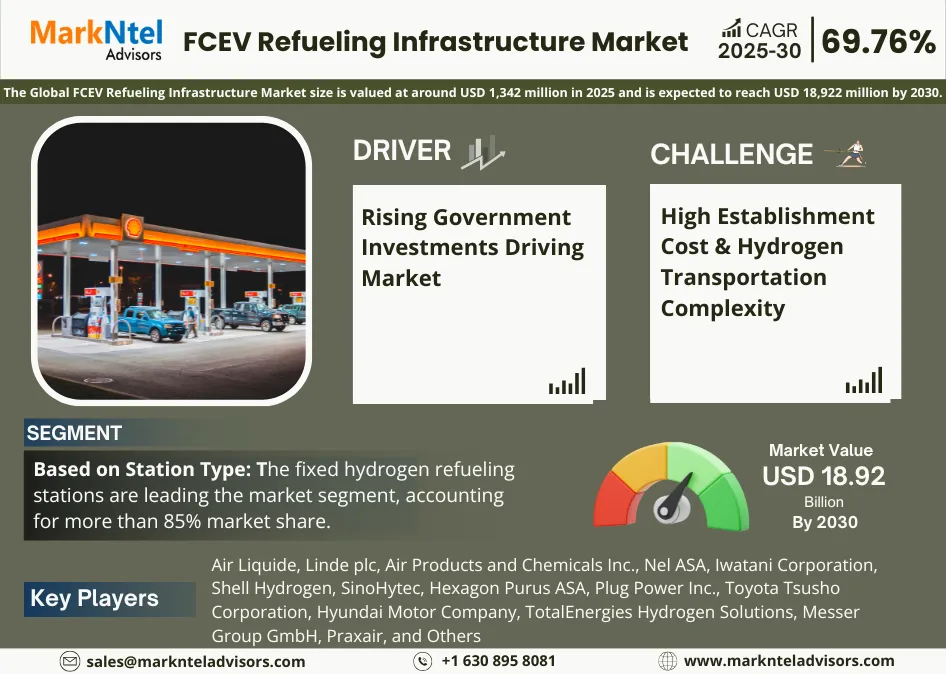Press Release Description
Significant Government Investments Driving Global FCEV Refueling Infrastructure Market at 69.76% CAGR During 2026-30
Global FCEV Refueling Infrastructure Market Overview, Trends, Size and Forecast: 2026-2030
The Global FCEV Refueling Infrastructure Market size is valued at around USD 1,342 million in 2025 and is expected to reach USD 18,922 million by 2030. Along with this, the market is estimated to grow at a CAGR of around 69.76% during the forecast period, i.e., 2026-30, cites MarkNtel Advisors in the recent research report. The market growth is largely influenced by several growth factors, including the active initiatives and policies to reduce environmental hazards and CO2 emissions, which are substantially caused by the transportation sector, the adoption of renewable fuels such as hydrogen, the expansion of green hydrogen-producing manufacturing units globally, and the technological advancements, such as mobile hydrogen refuelers to transport hydrogen.
One of the major growth factors is the growing partnerships among various energy companies and the countries’ governments, which are focusing on the expansion of more hydrogen refueling infrastructure across the world. For instance, the partnership between Hyundai (South Korea) and the energy companies like SK & POSCO, and the collaboration of Toyota (Japan) with ENEOS, to jointly expand hydrogen refueling infrastructure, are supporting the FCEV refueling infrastructure market. Additionally, the widespread acceptance of renewable resources, including green hydrogen as a fuel, is offering lucrative growth opportunities in this market. For instance, Germany, Spain, China, Japan, Australia, the USA, and many more are significantly allocating billions of dollars for funding to increase the infrastructure for green hydrogen production, thus contributing to the potential market growth.
Moreover, the rapid adoption of mobile hydrogen refuelers is positively shaping the market growth trajectory, as it is suitable for refueling FCEVs in areas with insufficient refueling stations. However, the difficulty in hydrogen transportation and high production costs to develop FCEC infrastructure are restraining further market growth & expansion, further states the research report, “Global FCEV Refueling Infrastructure Market Analysis, 2026.”

Global FCEV Refueling Infrastructure Market Segmentation Insights:
Fixed Hydrogen Refueling Stations Witness Massive Market Demand
Based on the station type, the market is further segmented into Fixed Hydrogen Refueling Stations, Mobile/Portable Hydrogen Refueling Stations. Out of these, the fixed hydrogen refueling stations hold the largest market share of more than 85%. For reference, more than a thousand hydrogen refueling stations are fixed at specific locations with an adequate supply of hydrogen for the fuel cell electric vehicles. The appropriate locations of these stations near highways and fleet hotspots are favoring their dominance in this market. Additionally, the high hydrogen storage potential of these stations and reduced refueling time support their supremacy over the mobile fuelers, with limited hydrogen storage capacities. Moreover, the strategy to build the fixed stations near the sites of direct electrolysers delivery or the green energy supply helps in reducing the transportation costs. Therefore, these highly preferred FCEV refueling stations hence dominating the Global FCEV Refueling Infrastructure Market.
Global FCEV Refueling Infrastructure Market Regional Analysis:
Asia-Pacific is the Epicenter of the FCEV Refueling Infrastructure Industry
The Global FCEV Refueling Infrastructure Market is largely dominated by the Asia-Pacific region, accounting for around 63% market share. This is leading due to the presence of large-scale production of hydrogen, which is the basic fuel used for FCEVs, in countries such as China, South Korea, and Japan. For instance, China produces tens of millions of tons of hydrogen per year, contributing to the market growth. Additionally, this region witnessed the highest number of refueling stations for FCEVs, as compared to other regions. Especially, China, South Korea, and Japan have hundreds of hydrogen refueling stations for FCEVs, showing the supremacy of Asia-Pacific in this global industry.
Moreover, the active support to develop the refueling infrastructure for FCEVs by the higher authorities of countries, including Japan, China, South Korea, Indonesia, Australia, India, etc. For reference, the partnership between Indonesia’s Pertamina NRE and Toyota (2024) to develop both fixed and mobile hydrogen refueling infrastructure in the country is accelerating the market growth, also in developing countries. Similarly, the Chinese and South Korean governments are aiming to establish new hydrogen refueling stations, respectively. These factors are contributing to the dominance of the Asia-Pacific in this global market
Top Companies in the Global FCEV Refueling Infrastructure Market
With strategic initiatives, such as mergers, collaborations, and acquisitions, the leading FCEV Refueling Infrastructure Market companies, including Air Liquide, Linde plc, Air Products and Chemicals Inc., Nel ASA, Iwatani Corporation, Shell Hydrogen, SinoHytec, Hexagon Purus ASA, Plug Power Inc., Toyota Tsusho Corporation, Hyundai Motor Company, TotalEnergies Hydrogen Solutions, Messer Group GmbH, Praxair, and Others are looking forward to increase their market size & share.
Key Questions Answered in the Research Report
- What is the scope, size, value, and forecast of the FCEV Refueling Infrastructure Market?
- What is the volume and share of each segment in the FCEV Refueling Infrastructure Market?
- What are the key trends shaping the FCEV Refueling Infrastructure Market from 2025 to 2030?
- What growth factors and risks impact the FCEV Refueling Infrastructure Market?
- What are the main challenges faced by players in the FCEV Refueling Infrastructure Market?
- What are the top opportunities in the FCEV Refueling Infrastructure Market?
- What does competitive analysis reveal about the FCEV Refueling Infrastructure Market landscape?
- Who are the key players and companies leading the FCEV Refueling Infrastructure Market?
- What innovations are transforming the future dynamics of the FCEV Refueling Infrastructure Market?
- How are partnerships and collaborations driving the FCEV Refueling Infrastructure Market growth?
- How does the FCEV Refueling Infrastructure Market differ based on geography and segments?
We offer flexible licensing options to cater to varying organizational needs. Choose the pricing pack that best suits your requirements:
Buy NowNeed Assistance?
WRITE AN EMAIL
sales@marknteladvisors.comCustomization Offered
100% Safe & Secure
Strongest encryption on the website to make your purchase safe and secure
